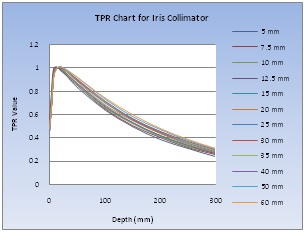Commissioning of two different algorithms for stereotactic Radiosurgery M6 FI+ CyberKnife system
Abstract
Introduction: Cyber Knife M6 FI+ a very precise robotic stereotactic radiosurgery system which is capable of delivering very high radiation dose to the tumour while minimizing radiation exposure to normal organs and tissues. MultiPlan treatment planning system is used with the CyberKnife unit and the algorithms used for optimization are Ray-Tracing and Monte Carlo. Our CyberKnife M6 FI+ system commissioning is done as per the vendor recommendation and meeting the local regulatory guidelines.
Materials and Methods: Clinical beam data measurement is carried out using Radiation Field Analyzer, Diode E, Pinpoint chamber, Semiflex ionization chamber and Unidose E Electrometer. FC-65 ionization chamber used in absolute dose calibration. The mechanical accuracy of the robot and image stability was verified using Radiochromic film (EBT3), E2E and Iris QA toolkits along with software. StereoPHAN is used for the patient-specific QA point dose measurement.
Results: Tissue phantom ratio, Off-centre ratio, Output factor, Percentage depth dose, open beam profile and absolute dose calibration are done as per the protocols. E2E performed for two different modes- static and motion. Iris aperture size measured for all the field sizes. The patient-specific QA delivered for both algorithms.
Discussion: Clinical beam data measurements are within ±1% of composite data set, overall standard deviation for Output Factors of the fixed and Iris collimators are 0.0026 and 0.0063. The absolute dose was calibrated to 1cGy per MU. E2E, Iris QA and Laser and radiation coincidence values are within the tolerance. Patient-specific QA point dose measurement variation for Ray-Tracing and Monte Carlo is 3% and 2%.
Conclusion: These exercises are mandatory to achieve the accurate, precise and high quality of treatment which also includes patient safety.
Downloads
References
Subhash C S, Joseph T,Jamone O, Williams B, Danny D. Commissioning and acceptance testing of a CyberKnife linear accelerator. J Appl Clin Med Phys.2007 Summer; 8(3): 119–125.
Sudahar H, Gopalakrishna K, Murali V, Velmurugan J. A phantom study to determine the optimum size of a single collimator for shortening the treatment time in Cyber Knife stereotactic radiosurgery of spherical targets. J Appl Clin Med Phys. 2012 Sep; 13(5): 33–45.
Cyber Knife robotic radiosurgery system Physics Essentials guide. Versions 10.6.x/5.3.x/3.x.
Gopalakrishnan K, CyberKnife: A new paradigm in radiotherapy. Editorial: J Med Phys 2010;35:63-4.
Sarah CH, Nikolaus K, Christoph F. A Novel Method for Quality Assurance of the CyberKnife Iris Variable Aperture Collimator.Cureus 2016 May; 8(5): e618.
International Atomic Energy Agency Technical Reports SeriesNo.398.Absorbed Dose Determination in External Beam Radiotherapy: An International Code of Practice for Dosimetry based on Standards of Absorbed Dose to Water.IAEA Publication. Vienna.MD: 2000.
Pantelis E, Antypas C, Petrokokkinos L, et al. Dosimetric characterization of CyberKnife radiosurgical photon beams using polymer gels. Med Phys. 2008 Jun;35(6):2312-20. DOI: https://doi.org/10.1118/1.2919099
Khan F M, Gibbon J. The physics of radiation therapy fifth edition.Lippincott Williams and Wilkins;2014.
Pan Y, Yang R, Li J, et al. Film-based dose validation of Monte Carlo algorithm for Cyberknife system with a CIRS thorax phantom. J Appl Clin Med Phys. 2018 May;19(3):142-148. doi: https://doi.org/10.1002/acm2.12314. Epub 2018 Mar 30.
Wilcox EE , Daskalov GM. Evaluation of GAFCHROMIC EBT film for Cyberknife dosimetry. Med Phys. 2007 Jun;34(6):1967-74. DOI: https://doi.org/10.1118/1.2734384.
Lee M, Kalani MY, Cheshier S, Radiation therapy and CyberKnife radiosurgery in the management of craniopharyngiomas. Neurosurg Focus. 2008;24(5):E4. doi: https://doi.org/10.3171/FOC/2008/24/5/E4.
International Commission on Radiation Units and Measurements (ICRU). Report No. 21. ICRU Publication. Bethesda. MD: 1972.
International Atomic Energy Agency TECDOC series no-1583.Commissioning Of Radiotherapy Treatment Planning Systems. Testing for typical external beam treatment techniques IAEA Publication.Vienna.MD 2008.
Bedford JL, Childs PL, Hansen NV, Shirazi MAM. Commissioning and quality assurance of the Pinnacle 3 radiotherapy treatment planning system for external beam photons. BJR.2003; Volume 76:163–176. doi: https://doi.org/10.1259/bjr/42085182.
Day MJ, Aird EG. The equivalent field method for dose determinations in rectangular fields. BJR Suppl. 1996;25:138-51.
Francescon P, Kilby W, Noll JM, et al. Monte Carlo simulated corrections for beam commissioning measurements with circular and MLC shaped fields on the CyberKnife M6 System: a study including diode, microchamber, point scintillator, and synthetic microdiamond detectors. Phys Med Biol. 2017 Feb 7;62(3):1076-1095. doi: https://doi.org/10.1088/1361-6560/aa5610. Epub 2016 Dec 29.
Griessbach I, Lapp M, Bohsung J, et al. Dosimetric characteristics of a new unshielded silicon diode and its application in clinical photon and electron beams. Med Phys. 2005 Dec;32(12):3750-4.
Sonja D, Carlo C, Cynthia FC, Alan BC, Jeffrey AG, Charles LL, Jessica RL, Maximian FS, David DT, Xiaodong W. American Association of Physicists in Medicine Task Group no 135 Quality assurance for robotic radiosurgery. Med Phys.2011.volume 38: 2312-2320.
Echner GG, Kilby W, Lee M, The design, physical properties and clinical utility of an iris collimator for robotic radiosurgery. Phys Med Biol. 2009 Sep 21;54(18):5359-80. doi: https://doi.org/10.1088/0031-9155/54/18/001. Epub 2009 Aug 18.
Malicki J. The importance of accurate treatment planning, delivery, and dose verification. Rep Pract Oncol Radiother. 2012 Mar 6;17(2):63-5. doi: https://dx.doi.org/10.1016%2Fj.rpor.2012.02.001. eCollection 2012.
Araki F. Monte Carlo study of a Cyberknife stereotactic radiosurgery system. Med Phys. 2006 Aug;33(8):2955-63.



 OAI - Open Archives Initiative
OAI - Open Archives Initiative


